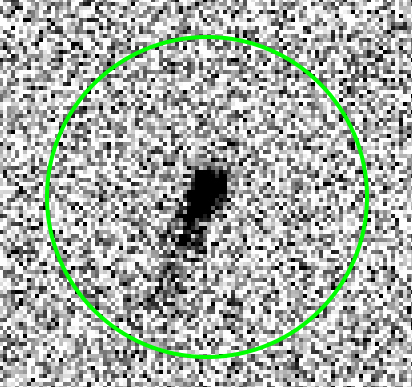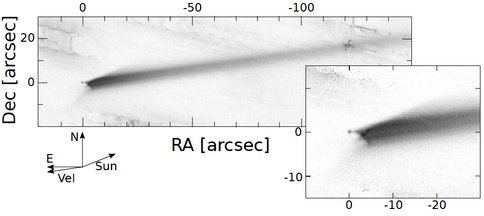2011 Annual Science Report
 University of Hawaii, Manoa
Reporting | SEP 2010 – AUG 2011
University of Hawaii, Manoa
Reporting | SEP 2010 – AUG 2011
Main Belt Comets
Project Summary
The distribution of volatiles, and in particular water, in our solar system is a primary determinant of solar system habitability, and understanding how volatiles were distributed throughout the solar system during the era of planetary formation. In particular, the origin of terrestrial water is a fundamental unresolved planetary science issue. There are three leading scenarios for its origin: direct capture from nebular gas, delivery from icy planetesimals, and chemical reactions between oxides in a magma ocean and a tenuous hydrogen atmosphere. Comets provide one of the mechanisms for large-scale transport and delivery of water within our solar system, and asteroids provide another source of volatiles. However, neither comets nor asteroids can explain both Earth’s water and its noble gas inventory. A recently discovered new class of icy bodies in the outer asteroid belt, the Main Belt Comets (MBCs), are comets in near-circular orbits within the asteroid belt that are dynamically decoupled from Jupiter. Dynamics suggest they formed in-situ, beyond the primordial snow line, and as such represent a class of icy bodies that formed at a distance from the Sun that has not yet been studied in detail and which could potentially hold the key to understanding the origin of water on terrestrial habitable worlds. The UH NAI team has been very active in searching for additional MBCs, and characterizing those that are known.
Project Progress
“Discovering the Main Belt Comets”
The first Main belt comets were discovered by accident, but now because of their importance in understanding the volatile distribution in the early solar system, surveys are being designed to find and characterize them.
We have been engaged in an automated search for new MBCs using data from the new survey telescope Pan-STARRS1 (PS1) telescope on Haleakalā, Maui. To search for MBCs, team member J. Kleyna has developed an image processing pipeline that taps into the PS1 data stream of hundreds of thousands of asteroid observations, extracts images, and performs a sensitive search for tail activity using a dust integrator to predict the tail direction. These low significance detections are then combined across repeated observations to flag potential MBC candidates for follow up observations using telescopes on Mauna Kea. PS1’s first “discovery” of an MBC occurred in the summer of 2010, when the activity of P/2010 La Sagra was imaged by PS1 before anyone else. Unfortunately, one of the images fell on a bright star, so the image sequence did not make it through the PS1 detection stream and our tail finding algorithm never had the opportunity be applied. Applied in retrospect, La Sagra was readily picked out by our methods.

The spectrum of MBC La Sagra with the underlying solar continuum removed. The three red error bars show the 1-sigma uncertainties in the 3 wavelength regions 3760-3830, 3830-3900 and 3900-3970 Angstroms.
A second technique is being used by H. Hsieh by comparing the measured image shape (point spread function; PSF) of the objects compared to the expected PSF width as determined from the median of all the PSFs of stars in the field along with the detection quality or signal-to-noise. This technique discovered MBC 2006 VW139 on 2011 Nov. 5, and pre-discovery images were then observed in data taken during August. A campaign to characterize this object is underway.
Graduate student H. Kaluna is testing a pilot program utilizing a third technique to discover MBCs in the PS1 data. This will search for objects that may not show detectable dust, but are anomalously bright. With dust that is close above the surface of the asteroid, there will be an increase in brightness due to an increased scattering cross section for light. By monitoring asteroids in the PS1 survey as they are periodically imaged during the course of the survey, Kaluna will develop the brightness light curve as a function of orbital phase. After removing the effects of observing geometry and rotational variation, any objects with excess brightness will be followed up with additional deep imaging observations to search for dust.
We are continuing our search for MBCs, and hope to find more as the quality of the PS1 data flow improves.
“Impacts in the Asteroid Belt – Masquerading as Main Belt Comets”
There were two recent discoveries that were announced as new MBCs on the basis of their orbits, and the observed dust tails. Both of these likely represent collisions in the asteroid belt and not ice-sublimation induced activity, but this was only inferred after extensive observations and analysis of the dust.
Asteroid (596) Scheila was reported to exhibit a cometary appearance and an increase in brightness on UT 2010 December 11, yet its orbit suggested it was associated with dynamically stable asteroid orbits. Team members B. Yang and H. Hsieh performed prompt near infrared and optical spectroscopy on this object on UT 2010 December 13 and 14 and 17 using Keck, Subaru and IRTF telescopes. The spectrum of Scheila showed a consistent red slope from 0.8 to 4.0 microns with no apparent absorption features, resembling spectra of D-type asteroids. Also, no sublimated gas was detected. Our observations suggested that its observed cometary-like activity was likely not caused by the sublimation of water ice. Instead, the dust coma and tail may have been the result of a recent impact event.
P/2010 A2 LINEAR was discovered on 2010 January 7 with a straight tail, and based on its orbit was classified as a new MBC. Several groups used the Hubble Space Telescope, the Rosetta spacecraft and other large ground-based telescopes and concluded that this was an asteroid collision. Shortly after discovery, our team, lead by collaborator O. Hainaut, secured time on telescopes in Chile and on Mauna Kea. Our dust-dynamical models and thermal models indicate that the tail structure is consistent with a single impulsive event (e.g. an impact) rather than dust that was dragged from the nucleus by escaping gas sublimating from sub-surface ice. The dust contained in the tail is estimated to at least 800 M kg, which would form a sphere of 40 m radius (with a density of 3,000 kg m−3 and an albedo p = 0.11 typical of S-type asteroids). More advanced models suggest a very low ejection velocity and very low surface material strength.
Composite image of P/2010 A2 LINEAR obtained using the Gemini North telescope on Mauna Kea on 19.5 January 2010. The stars have been removed from the stacked images to more clearly show the tail. The inset shows details of the inner structure.
“Detailed Studies of Main Belt Comets”
Key to understanding the activity in MBCs is the ability to perform follow up observations, and this means that after discovery there needs to be sufficient observations to determine a good orbit. MBC P/2008 R1 (Garradd) was not observed over a sufficient orbit arc length after discovery to ensure recovery, in part because of its small size. UHNAI postdoc J. Kleyna lead successful Gemini 8 m observations to recover the MBC at mag 25.9, yielding a very small nucleus (r~0.4 km). This has important implications for understanding how ice can survive the age of the solar system in such small bodies, which we are exploring.
We also studied the recently discovered MBC P/2010 R2 (La Sagra) using various telescopes. P/La Sagra wass seen to increase in brightness by >1 mag between August 2010 and December 2010, suggesting that dust production was ongoing over this period. These results strongly suggested that the observed activity is cometary in nature (i.e., driven by the sublimation of volatile material), and that P/La Sagra is a new Main-belt comet.
During 2010 July and August MBC 238P/Read was observed to be active for a second perihelion passage since its discovery, and we followed the development of the dust tail throughout the fall. This confirmed that that this object was a true MBC and producing dust from a collision since only a thermally-driven event would produce repeated activity after the closest approach to the sun. Water-ice sublimation models suggest that the ice is buried deep within the MBC and not near the surface.
A survey of mid-IR observations with the NEO-WISE mission yielded detections of 3 MBCs (P/2010 R2 La Sagra, 133P/Elst-Pizarro and 176P/Linear) when they were inactive allowing for measurements of their diameters and albedos, and detections of the 2 asteroid impact objects allowed for constraints of the particle mass distributions.

– The detection of P/2010 La Sagra in PS1 data in the summer of 2010. The circle is 10 arcseconds across. Our detection algorithms easily detect activity well below what is seen in the figure.

Spectrum of asteroid 596 Scheila. Open squares are the Subaru observation of Scheila obtained on UT 2010 Deember 14. The red dashed line is the best-fit Hapke radiative transfer model, fit with amorphous carbon (AC) and the mineral pyroxene (pyr). No absorption features were observed, suggesting that surface water ice was less than 1 wt% on this object.
Publications
-
Bauer, J. M., Mainzer, A. K., Grav, T., Walker, R. G., Masiero, J. R., Blauvelt, E. K., … Wright, E. L. (2012). WISE /NEOWISE OBSERVATIONS OF ACTIVE BODIES IN THE MAIN BELT. The Astrophysical Journal, 747(1), 49. doi:10.1088/0004-637x/747/1/49
-
Hainaut, O. R., Kleyna, J., Sarid, G., Hermalyn, B., Zenn, A., Meech, K. J., … Yang, B. (2012). P/2010 A2 LINEAR. A&A, 537, A69. doi:10.1051/0004-6361/201118147
-
Hsieh, H. H., Meech, K. J., & Pittichová, J. (2011). MAIN-BELT COMET 238P/READ REVISITED. The Astrophysical Journal, 736(1), L18. doi:10.1088/2041-8205/736/1/l18
-
Hsieh, H. H., Yang, B., & Haghighipour, N. (2011). OPTICAL AND DYNAMICAL CHARACTERIZATION OF COMET-LIKE MAIN-BELT ASTEROID (596) SCHEILA. The Astrophysical Journal, 744(1), 9. doi:10.1088/0004-637x/744/1/9
-
Hsieh, H. H., Yang, B., Haghighipour, N., Kaluna, H. M., Fitzsimmons, A., Denneau, L., … Tonry, J. L. (2012). DISCOVERY OF MAIN-BELT COMET P/2006 VW 139 BY Pan-STARRS1. The Astrophysical Journal, 748(1), L15. doi:10.1088/2041-8205/748/1/l15
-
Hsieh, H. H., Yang, B., Haghighipour, N., Novaković, B., Jedicke, R., Wainscoat, R. J., … Snodgrass, C. (2012). OBSERVATIONAL AND DYNAMICAL CHARACTERIZATION OF MAIN-BELT COMET P/2010 R2 (La Sagra). The Astronomical Journal, 143(5), 104. doi:10.1088/0004-6256/143/5/104
- Kleyna, J., Hainaut, O.R. & Meech, K.J. (2012, Submitted). P/2010 A2 LINEAR II: Dynamical Dust Modeling. Astron. Astrophys.
-
PROJECT INVESTIGATORS:
-
PROJECT MEMBERS:
Karen Meech
Project Investigator
Henry Hsieh
Co-Investigator
Jacqueline Keane
Co-Investigator
Jan Kleyna
Co-Investigator
Timm Riesen
Co-Investigator
Gal Sarid
Co-Investigator
Bin Yang
Co-Investigator
Olivier Hainaut
Collaborator
Brendan Hermalyn
Collaborator
Jana Pittichova
Collaborator
Heather Kaluna
Graduate Student
Laurie Urban
Graduate Student
Anthony Zenn
Graduate Student
-
RELATED OBJECTIVES:
Objective 1.1
Formation and evolution of habitable planets.
Objective 2.2
Outer Solar System exploration
Objective 3.1
Sources of prebiotic materials and catalysts
